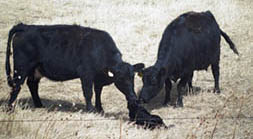Retained placenta? What to do (and not do)

4/3/23
CHARITON, Iowa — Retained placentas can seem very problematic. They can look bad and smell even worse, especially if a cow goes more than a couple of days without cleaning. Your gut instinct may be to put on some gloves and pull it out. In this case, however, Iowa State University extension beef specialist Chris Clark says, "Don't listen to your gut!"
"Manual removal of the placenta can actually cause tiny tears in the uterine tissue, which can impact reproductive capability," Clark said. "The best course of action often is to be patient and do nothing. Generally, untreated cows expel the fetal membrane in two to 11 days and bounce back relatively quickly."
If long strands are hanging where dirt and manure contamination can occur, a knot can be tied or tissue can be cut to a shorter length. Again, do not pull with anything more than very light pressure, as mechanical removal has significant risk of internal tissue damage and subsequent metritis.
It is important to keep a close eye on these cows, Clark said, because those that show signs of systemic illness such as fever, depression, lethargy and anorexia require treatment.
In addition, some dairy literature shows about 50% of retained placenta cases result in metritis, or uterine infection. Always work with your local veterinarian when determining if, when and what treatment route may be warranted. Following a retained placenta, particularly if metritis occurred, expect return to estrus to be delayed.
"It can be difficult to know whether an occasional slow-to-clean cow is just a fluke or a sign of a bigger, underlying issue," Clark said. "Predisposing factors for retained placentas include vitamin/mineral deficiencies, poor body condition, abortions and premature calves."
A good practice is to take thorough records of assisted births, twins, retained placentas, weak calves, etc. By recording and tracking the frequency of the infrequent but occasional hiccups in the calving season, you can use that data to identify effective prevention methods such as adjustments to nutrition, genetic and health protocols.
-30-
The Iowa Beef Center at Iowa State University was established in 1996 with the goal of supporting the growth and vitality of the state’s beef cattle industry. It comprises faculty and staff from Iowa State University Extension and Outreach, College of Agriculture and Life Sciences and College of Veterinary Medicine, and works to develop and deliver the latest research-based information regarding the beef cattle industry. For more information about IBC, visit www.iowabeefcenter.org.
Contacts:
Chris Clark, Iowa State University Extension beef specialist, 712-250-0070, caclark@iastate.edu
Beth Reynolds, ISU Extension and Outreach program specialist- 515-294-9881, bethr@iastate.edu
Writer:
Sherry Hoyer, Iowa Beef Center, 515-294-4496, shoyer@iastate.edu
